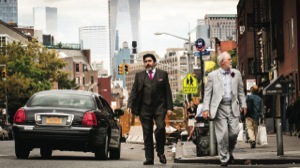
Why Ira Sachs titled his latest film Love is Strange is unclear. Nothing about the love depicted in the film – between Ben and George, together for 39 years; between Elliot and Kate, together 19 years; between young lovers Ted and Roberto; between Eliot and Kate and their son Joey – is remotely weird. These are all utterly familiar relationships, at times tender, frustrated, warm, resigned and relaxed. While their love is actually quite ordinary, the situations Sachs and his co-writer Mauricio Zacharias put their characters through is definitely odd, even unbelievable. But within this mixture of the familiar and the weird is a touching, often beautiful, and often quiet film about gay marriage, straight marriage and the hopes and expectations we place on our families.
The film begins with Ben (John Lithgow) and George (Alfred Molina) marrying in a garden in the West Village of New York and celebrating with their delighted, adoring friends and family in the immaculately appointed apartment. Kate (Marisa Tomei), the wife of Ben’s nephew Elliot (Darren E. Burrows), gives a toast declaring Ben and George the greatest couple she’s ever known, and everyone cheers. Ben and George seem to have the ultimate upper middle class homonormative life; I was a little jealous.
In the next scene, however, we see George at work, directing the choir of a Catholic school. The head of school calls him to his office and tells him that because George and Ben made their marriage so public by posting it on Facebook, the bishop has demanded that George be fired. (This even wouldn’t happen if the religious-exemption-less ENDA was passed.) Suddenly, Ben and George have to sell their apartment and ask their closest family and friends to put them up while they find a new home.
How they could have afforded the place on the salary of a choir director – when Ben was a retired unsuccessful painter – isn’t clear. And even less clear is why the two are forced to stay in separate places during the horrible transition; Ben is in the lower bunk of Kate and Elliot’s son Joey’s bunk bed and George is on the couch at Ted and Roberto’s. Housing in New York is crazy, but this seemed like the manipulation of the screenwriters’ marionette strings, not the natural course of events. Sachs and Zacharias wanted to get Ben and George discomfited by different family lives and different love styles.
Ben is in the most emotionally wrought situation. Elliot is never home, Kate can’t get work done with Ben always around chatting with her, and Joey is a teenage boy, confused, awkward and resentful of the demands of the adults around him. George, on the other hand, is just an old guy living with socially active young gay men, and he’s annoyed with their late, loud parties. After four decades of domesticity, they hate being apart, and the scene in which George shows up crying at Kate’s late at night, in the pouring rain, just so he could sleep with his husband is immensely touching.
As the film progresses, Sachs and Zacharias throw a number of curveballs at the characters, some weird and implausible and others rather clichéd. But the actors and Sachs’ beautiful and sensitive direction of them ground their lives and their emotions in a recognizable, bittersweet reality. Everyone in the cast is excellent, but Lithgow is particularly amazing as the adorably ditzy, powerfully wise, achingly sweet Ben.
It’s not as flashy a role as Christopher Plummer’s Oscar winning Hal Fields in Beginners, but Lithgow is just as good, playing something we need in American films: a great gay man, aging gracefully.
MOVIE REVIEW
Love is Strange
Directed by Ira Sachs
Written by Ira Sachs and Mauricio Zacharias
Starring John Lithgow, Alfred Molina and Marisa Tomei
Inexplicably rated R
Opens Aug. 29 at Landmark Hillcrest











